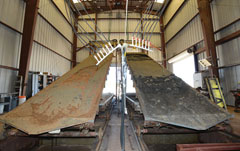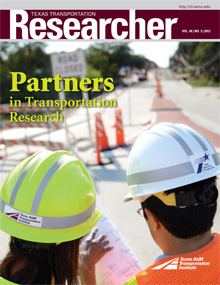The science of simulating rainfall is more complicated than you might think. Simulated raindrops need to be the right shape and velocity in order to produce the same effect as the real thing. And getting as close to the real thing as possible — in a controlled environment where results can be reproduced — is an important part of the Texas A&M Transportation Institute’s (TTI’s) Hydraulics, Sedimentation and Erosion Control Laboratory (HSECL) — a facility that will soon be expanding.
The indoor rainfall simulator subjects soil beds covered with erosion-control materials to three days of simulated rainfall to see how much soil the water carries away with it. Researchers replace the beds and replicate the test twice more to ensure the reliability of their results. And TTI’s sponsors, like the Texas Department of Transportation (TxDOT), know the value of those results.
“TxDOT requires that erosion-control materials be on their Approved Products List in order for contractors to use the materials on TxDOT projects,” says Jett McFalls, TTI assistant research scientist and manager of the HSECL. “To get on the list, products need to be tested by TTI and pass the required performance criteria. Contractors can then select an erosion-control product from the list depending on the slope and type of soil where it’ll be used.”

Currently, the lab has a waiting list, which can take more than a year for a manufacturer’s product to be tested. Recent improvements to the facility include adding doors for better access, adding a bridge crane to lift collection bags out of the water-collection bays (instead of manually), and widening the bays for forklift access. These additions have improved setup and collection time, but there’s still high demand for TTI testing.
“Right now, the lab tests two beds at a time, sand and clay, for each product,” says McFalls. “We’ve seen so many requests that TTI is expanding the lab to a second building. We’ll have three additional beds — two to test products and a third to use for things like sponsored research. The addition will provide more flexibility for conducting research for a wide range of sponsors.”
In addition, the expansion will allow the HSECL to be ASTM certified. “The new test beds will conform to ASTM International’s criteria for testing,” says Dennis Markwardt, director of vegetation management at TxDOT. “This will lend even more credibility to our data and ensure that we have good options for products that perform as stated, to stop erosion and provide good future performance. Numerous states use our data to make decisions as well.”
The second indoor rainfall simulator building will be constructed next to the existing building, with a covered area between the two buildings to protect prepared soil beds from the elements. Wet beds can affect data, so test beds start out dry. Additionally, TTI will build a soil storage building to protect the soil researchers use for their testing. The new facilities should be up and running by the spring of 2013.
